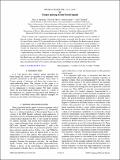| dc.contributor.author | Metlitski, Max A. | |
| dc.contributor.author | Mross, David Fabian | |
| dc.contributor.author | Sachdev, Subir | |
| dc.contributor.author | Todadri, Senthil | |
| dc.date.accessioned | 2015-03-05T16:09:28Z | |
| dc.date.available | 2015-03-05T16:09:28Z | |
| dc.date.issued | 2015-03 | |
| dc.date.submitted | 2015-01 | |
| dc.identifier.issn | 1098-0121 | |
| dc.identifier.issn | 1550-235X | |
| dc.identifier.uri | http://hdl.handle.net/1721.1/95873 | |
| dc.description.abstract | States of matter with a sharp Fermi surface but no well-defined Landau quasiparticles arise in a number of physical systems. Examples include (i) quantum critical points associated with the onset of order in metals; (ii) spinon Fermi-surface [U(1) spin-liquid] state of a Mott insulator; (iii) Halperin-Lee-Read composite fermion charge liquid state of a half-filled Landau level. In this work, we use renormalization group techniques to investigate possible instabilities of such non-Fermi liquids in two spatial dimensions to Cooper pairing. We consider the Ising-nematic quantum critical point as an example of an ordering phase transition in a metal, and demonstrate that the attractive interaction mediated by the order-parameter fluctuations always leads to a superconducting instability. Moreover, in the regime where our calculation is controlled, superconductivity preempts the destruction of electronic quasiparticles. On the other hand, the spinon Fermi surface and the Halperin-Lee-Read states are stable against Cooper pairing for a sufficiently weak attractive short-range interaction; however, once the strength of attraction exceeds a critical value, pairing sets in. We describe the ensuing quantum phase transition between (i) U(1) and Z[subscript 2] spin-liquid states; (ii) Halperin-Lee-Read and Moore-Read states. | en_US |
| dc.description.sponsorship | National Science Foundation (U.S.) (Grant NSF PHY11-25915) | en_US |
| dc.description.sponsorship | National Science Foundation (U.S.) (Grant DMR-1360789) | en_US |
| dc.description.sponsorship | Templeton Foundation | en_US |
| dc.description.sponsorship | United States. Dept. of Energy (DESC-8739- ER46872) | en_US |
| dc.description.sponsorship | Simons Foundation (Simons Investigator Grant) | en_US |
| dc.description.sponsorship | Canada. Industry Canada | en_US |
| dc.description.sponsorship | Ontario. Ministry of Research and Innovation | en_US |
| dc.publisher | American Physical Society | en_US |
| dc.relation.isversionof | http://dx.doi.org/10.1103/PhysRevB.91.115111 | en_US |
| dc.rights | Article is made available in accordance with the publisher's policy and may be subject to US copyright law. Please refer to the publisher's site for terms of use. | en_US |
| dc.source | American Physical Society | en_US |
| dc.title | Cooper pairing in non-Fermi liquids | en_US |
| dc.type | Article | en_US |
| dc.identifier.citation | Metlitski, Max A. et al. “Cooper Pairing in Non-Fermi Liquids.” Physical Review B 91.11 (2015). © 2015 American Physical Society. | en_US |
| dc.contributor.department | Massachusetts Institute of Technology. Department of Physics | en_US |
| dc.contributor.mitauthor | Todadri, Senthil | en_US |
| dc.relation.journal | Physical Review B | en_US |
| dc.eprint.version | Final published version | en_US |
| dc.type.uri | http://purl.org/eprint/type/JournalArticle | en_US |
| eprint.status | http://purl.org/eprint/status/PeerReviewed | en_US |
| dc.date.updated | 2015-03-04T23:00:09Z | |
| dc.language.rfc3066 | en | |
| dc.rights.holder | American Physical Society | |
| dspace.orderedauthors | Metlitski, Max A.; Mross, David F.; Sachdev, Subir; Todadri, S. | en_US |
| dc.identifier.orcid | https://orcid.org/0000-0003-4203-4148 | |
| mit.license | PUBLISHER_POLICY | en_US |
| mit.metadata.status | Complete | |
